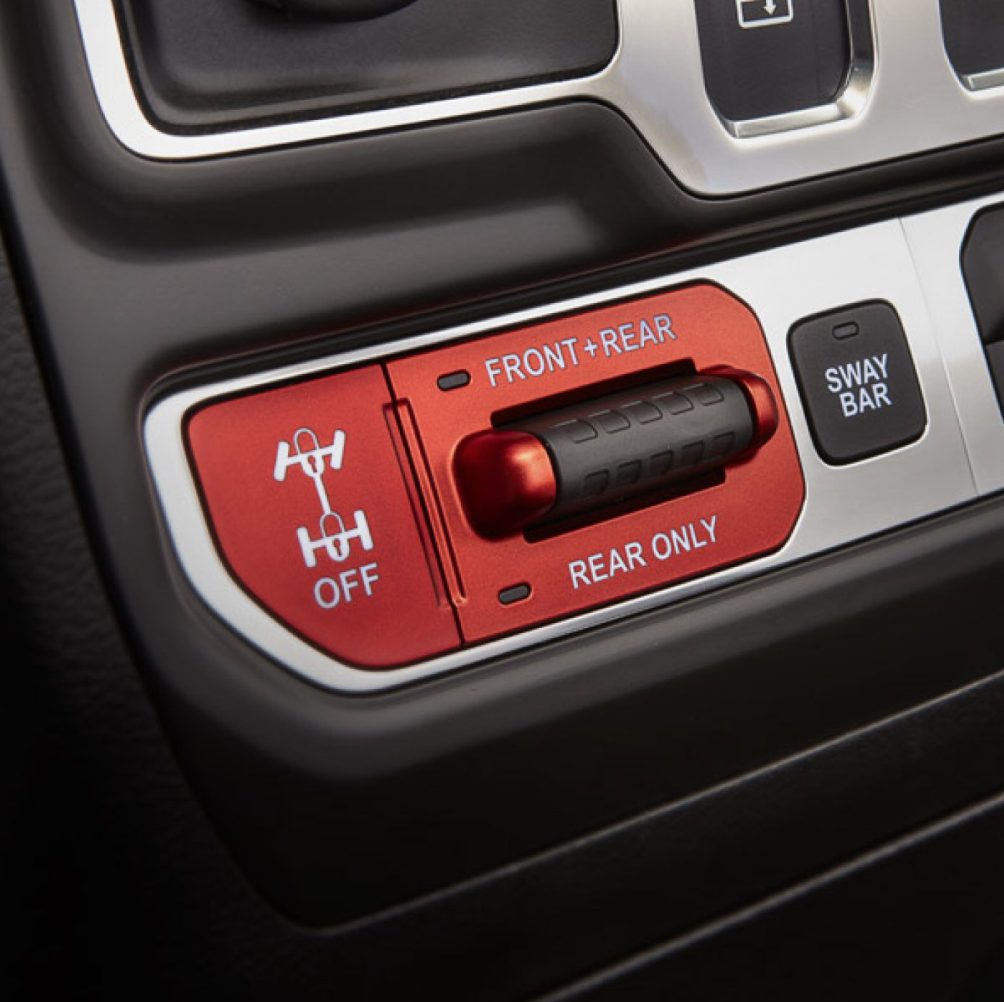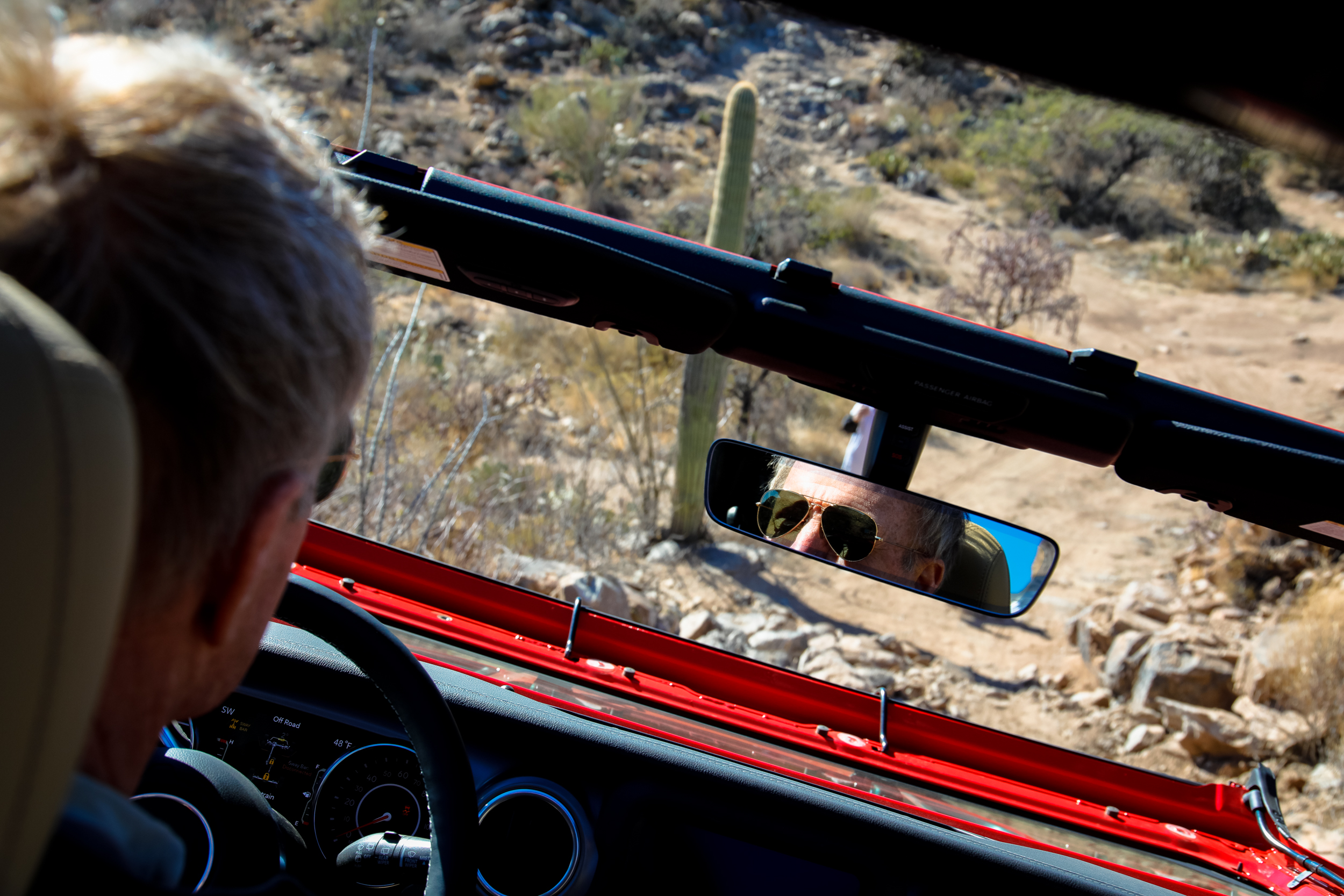The JL Wrangler Part 2: Rubicon
Scuffing tires on the demo course. Matt Scott photo.
I wonder if any of the corporate liability attorneys who signed off on the Jeep Wrangler Rubicon’s front and rear diff locks, anti-roll-bar disconnect, 4:1 transfer case, and 77:1 crawl ratio were ever given a demonstration of the vehicle’s capabilities.
Probably not. “Oh, those modifications? They, um, just help traction. You know, to enhance safety,” the engineers told them, winking broadly at each other.
And in a very real sense the engineers were telling the truth—it’s just that they were referring to traction on, say, a 30-degree hillclimb studded with boulders the size of engine blocks. Which is where I found myself, with FCA’s Scott Brown in the passenger seat, in an arrest-me-if-you-can-follow-me-red two-door Rubicon, top removed and windshield folded down. The eight-speed auto box was manually selected to first in low range, anti-roll bar disconnected, and both diffs locked. I noted with approval that (along with the anti-roll bar switch) the JL’s diff-lock selector has been moved to the center of the dash for easy access (in a bright red escutcheon to boot), and hugely simplified from the JK’s: Push down for rear lock, up for front and rear. Amazingly, the new electrohydraulic power steering gave me zero indication that the front wheels were rigidly joined; normally a locked front diff firms up even power steering noticeably.
Much-simplified diff-lock control. "Sway bar" button disconects front anti-roll-bar.
Through the windshield there was a lot of blue Arizona sky, and spotter Jim Horne’s arms motioning me straight up, and up, and then left across the boulders. Scott and I transitioned from being pressed into our seats to being pressed, respectively, against the center console and driver’s door. The side/down slope was enough to make Scott give a little whoop of excitement, and for me to appreciate the integrated roll cage surrounding us. The Jeep, of course, was loafing, idling in that 77:1 crawl ratio at half walking speed, each BFG All-Terrain tenaciously gripping granite (the techs hadn’t even bothered to air them down). A turn right back towards the sky, a pause while Jim wedged an extra rock under the left rear tire, then we were over, and being waved on to the next obstacle by the next spotter. (That particular hill would shortly be closed down for rebuilding after another journalist repeatedly applying too much throttle while ignoring instructions managed to send a bunch of those engine blocks tumbling down the slope.)
Jim Horne guides a Rubicon Unlimited up the hill.
The JL Sahara Matt Scott and I had driven to get to the staging area had impressed me with its capability, and driver-independent traction-control systems are getting better with each generation. But the Rubicon is in a different universe. Even the best ABS-based traction control can’t match the ability to manually lock one or both axle differentials in advance of a limited-traction situation. Flip that center toggle switch upward in the Rubicon and you have Four. Wheel. Drive. Period. Combine that with the disconnectable front anti-roll bar, which hugely increases compliance—and comfort—on a rough trail, and a crawl ratio slow enough to let you watch cactus grow on your way past, plus excellent approach and departure angles (44º and 37º), standard BFG All-Terrains, etc. etc., and you have a vehicle unmatched by anything in its class in terms of backcountry capability—either in the U.S. or the rest of the world.
That much capability necessitates a strong foundation to withstand the stresses involved in powering a 4,300-pound vehicle up a torturous slope. While the JK Rubicon was more than up to the task, the JL raises the bar. The fully boxed chassis now employs 80 percent high-strength steel, with five boxed crossmembers. Torsional rigidity is up by 18 percent, yet, the factory claims, weight is down by 100 pounds. The next-generation Dana 44 axles have been improved as well: The front axle tubes are 10 percent larger in diameter, 14 percent thicker, and twice as strong as the previous versions. End forgings on the Rubicon are 11 percent stronger. Components no driver could ever notice have been studied, critiqued, and tweaked.
FCA's Scott Brown rides along. Matt Scott photo.
FCA’s introduction and their excellent driving course left little doubt that the JL Rubicon is everything the JK Rubicon was, and more. (Some might see the move from BFG Mud-Terrains to All-Terrains as a retrograde step, but it’s not. In a majority of situations not involving mud, ATs are the equal of if not superior to MTs. And the new tires certainly help reduce road noise, and definitely bump fuel economy.) So the Rubicon’s bona fides for competency in extremely rugged terrain remain unmatched by anything in its class. If you’re looking for a vehicle that can serve as a perfectly comfortable daily driver, then be nearly invincible for weekend explorations of any trail you have the skill to drive, it remains the icon.
The question is: If I were considering a Wrangler as an overlanding vehicle—that is, for long-distance, self-sufficient travel on a mixture of paved and dirt roads, with four-wheel drive sections definitely in the mix but little emphasis on difficult passages unless they were unavoidable due to route or weather—and if my funds were not bottomless, which way would I go? I evaluated two approaches, both of them the Unlimited (four-door) body style:
- Go basic and order a Wrangler Sport with suitable options. On FCA’s new Wrangler build site I specced a Sport with the same Pentastar V6 and excellent ZF eight-speed automatic transmission as the Rubicon, the standard black hardtop, Anti-Spin rear diff, all-terrain tires, and a few other relevant bits such as heavy duty electrics (240-amp alternator, 700-amp battery), etc., for $36,305. It would have the simple Command-Trac part-time four-wheel-drive transfer case with ABS-based traction control (which Jeep refers to as a differential brake). To be honest, this system is capable of handling 99 percent of the terrain I have experienced on extended journeys in South America, Australia, and Africa, even completely off-tracks forays into Egypt’s sand seas. (The Anti-Spin diff is designed to seamlessly handle slight differences in cross-axle traction; the more intrusive ABS- based traction control kicks in for more extreme variations.) Jeep lists the cargo capacity if the Sport at a middling 1,000 pounds, not including the driver. (One of the few disappointments of the JL redesign is the lack of a heavier GVWR option. I wonder if the upcoming pickup version will raise this.)
- Finance a bigger chunk and go for the Rubicon. In addition to the drivetrain and suspension features—4:1 transfer case, electric locking differentials front and rear, driver disconnectable front anti-roll bar, 4:11 diff ratios—the Rubicon boasts other standard features not available on the Sport: premium seats, an AC power outlet, a seven-inch touch screen, power heated mirrors, remote keyless entry, plus several premium options. I went through its build list, not going crazy with leather upholstery or any similar spurious extras, but nevertheless equipping it more upscale than the Sport, and came to $48,090. (I could easily have added another $4,000-$5,000 in bling.) Cargo capacity of the Rubicon is even less than the Sport—890 pounds.
Despite the slightly higher GVWR of the Sport, I’m pretty sure that for either vehicle I’d want heavier-duty rear springs and shocks if I planned on traveling with a passenger and a full load of equipment, food, and water. Even a load nearing but not surpassing the factory limit would depress the stock rear springs enough to upset the ride height and headlamp alignment. So that modification would cost about the same for either vehicle. Otherwise, what does one get for the extra $12,000 of the Rubicon besides—let’s not diminish this—the knowledge that anywhere in the world you traveled you would be able to tackle the toughest routes passable by any stock vehicle?
One answer worth considering lies in those next-generation Dana 44 axles, a significant step up in strength and durability from those fitted to the Sport. Note: I absolutely do not think the Sport is under-equipped in that category (as long as you don’t try to cram stupidly oversized tires on it), but the overwhelming priority for an overland vehicle is reliability and durability, and there is no doubt that the Dana 44s would optimize that in a Wrangler.
On the other hand, the higher (i.e. numerically lower) final drive ratio of the Sport—3.45 vs. 4.10—might make for slightly more relaxed freeway cruising at the expense of low-range crawling. However, with the eight-speed auto transmission on each, and taller tires of the Rubicon, I’m not sure how noticeable this will be, and I did not have a chance to directly compare the two, as I only had access to the Rubicon in the dirt.
Of course the extra comfort (I wouldn’t classify them as “luxury”) items standard or available on the Rubicon would make traveling a bit more relaxing.
In the end—and I hope this doesn’t sound like a copout—I would buy the Rubicon if I had the funds, and be completely happy with the Sport if I did not. In fact, I’d leave for a trans-Africa trip in either with no hesitation.
Remembering to pack carefully, of course.
Thanks for the photos, Matt!





